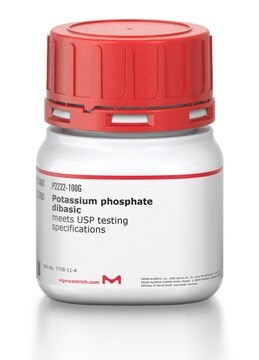1.05104
Potassium phosphate dibasic
anhydrous for analysis EMSURE®
Synonym(s):
Potassium phosphate dibasic, Dipotassium hydrogen phosphate, Potassium phosphate dibasic, Dipotassium Phosphate, di-Potassium hydrogen phosphate, Dipotassium hydrogenphosphate, Dipotassium phosphate, sec.-Potassium phosphate
About This Item
Recommended Products
Quality Level
product line
EMSURE®
Assay
≥99.0% (alkalimetric)
form
solid
potency
8000 mg/kg LD50, oral (Rat)
loss
≤1% loss on drying, 130 °C
pH
9 (20 °C, 10 g/L in H2O)
solubility
1600 g/L
density
2.44 g/cm3 at 20 °C
bulk density
700‑1000 kg/m3
anion traces
chloride (Cl-): ≤0.003%
sulfate (SO42-): ≤0.005%
cation traces
Fe: ≤0.0010%
N: ≤0.001%
Na: ≤0.5%
heavy metals (as Pb): ≤0.0005%
storage temp.
15-25°C
SMILES string
[K+].[K+].OP([O-])([O-])=O
InChI
1S/2K.H3O4P/c;;1-5(2,3)4/h;;(H3,1,2,3,4)/q2*+1;/p-2
InChI key
ZPWVASYFFYYZEW-UHFFFAOYSA-L
Looking for similar products? Visit Product Comparison Guide
Related Categories
Application
- Bromination of aromatic compounds by residual bromide in sodium chloride matrix modifier salt during heated headspace GC/MS analysis.: This research investigates the role of potassium phosphate dibasic in the bromination of aromatic compounds, providing insights into its application in GC/MS analysis (Fine et al., 2013).
- Purification of porcine pancreatic lipase by aqueous two-phase systems of polyethylene glycol and potassium phosphate.: The study details the use of potassium phosphate dibasic in the purification of porcine pancreatic lipase using an aqueous two-phase system, demonstrating its utility in biochemical separation processes (Zhou et al., 2013).
- Cloning, purification, crystallization and preliminary X-ray crystallographic analysis of a cyclophilin A-like protein from Piriformospora indica.: This article discusses the use of potassium phosphate dibasic in the crystallization process of a cyclophilin A-like protein, contributing to structural biology research (Bhatt et al., 2012).
- A validated enantioselective HPLC assay of dexibuprofen in dexibuprofen tablet formulations.: Potassium phosphate dibasic is utilized in the development of an enantioselective HPLC assay for dexibuprofen, enhancing pharmaceutical analysis techniques (Awad et al., 2012).
- Monitoring of phenylurea and propanil herbicides in river water by solid-phase-extraction high performance liquid chromatography with photoinduced-fluorimetric detection.: The study employs potassium phosphate dibasic in the analysis of herbicides in river water, demonstrating its application in environmental monitoring and water quality assessment (de la Peña et al., 2003).
Analysis Note
pH-value (5 %; water): 8.7 - 9.3
Chloride (Cl): ≤ 0.003 %
Sulfate (SO₄): ≤ 0.005 %
Total nitrogen (N): ≤ 0.001 %
Heavy metals (as Pb): ≤ 0.0005 %
Fe (Iron): ≤ 0.0010 %
Na (Sodium): ≤ 0.5 %
Loss on drying (130 °C): ≤ 1.0 %
Legal Information
Not finding the right product?
Try our Product Selector Tool.
Storage Class Code
13 - Non Combustible Solids
WGK
WGK 1
Flash Point(F)
Not applicable
Flash Point(C)
Not applicable
Certificates of Analysis (COA)
Search for Certificates of Analysis (COA) by entering the products Lot/Batch Number. Lot and Batch Numbers can be found on a product’s label following the words ‘Lot’ or ‘Batch’.
Already Own This Product?
Find documentation for the products that you have recently purchased in the Document Library.
Customers Also Viewed
Protocols
This paper illustrates the setting up of a Lopinavir assay following European pharmacopoeia guidelines (10.2), and using a shorter column packed with smaller particles. The described assay saves valuable time and improves separation efficiency, which typically translates to better method performance.
Our team of scientists has experience in all areas of research including Life Science, Material Science, Chemical Synthesis, Chromatography, Analytical and many others.
Contact Technical Service




